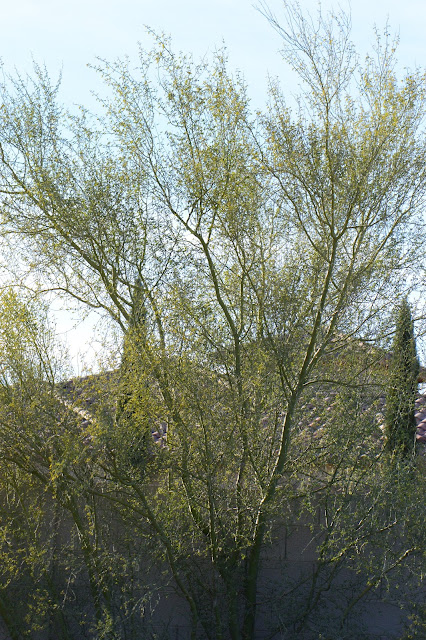As I said, we have had some rain, and there are patches of green grass on the way there. This small swathe of green lies in front of a creosote bush (Larrea tridentata).
Further on, the cluster of Blue Palo Verde trees (Parkinsonia florida) that I am following is looking bright and happy...
...though most of the leaves have a yellowish cast. Looking back over past posts, I see that I've mentioned yellow leaves at least since November. It would seem to be a winter phenomenon and has increased each month since. These trees do not drop their leaves in our normally mild winters (they are summer deciduous instead to cope with drought), but it would seem that they do turn colour a little bit!
...and even more dramatically here...
...while those on the sunlit branches were still open.
Definitely a sun-loving tree! Though I can't be certain that shade is the cause...
For the rest, it is its usual self, with dainty, rounded leaves and green bark.
The foliage has filled in since last month, which was quite dry. January has already seen some good rainy weather so the trees can afford to put out some extra leaves.
While out, I was also able to take some pictures of the beautifully striped branches of the so-called Creosote Bush (Larrea tridentata); those pictures are up at the Journal of a Thousand Things.
Here is a last close-up of the somewhat yellowed leaves of the Palo Verde trees, lightly folded.
Weather Diary: Fair with light clouds; High: 64 F (18 C)/Low: 36 F (2 C)









Beautiful colours - and fascinating folding leaves!
ReplyDeleteI can maybe see why some flowers close in the shade, perhaps to protect the pollen etc, but not sure what benefit the folding leaves have. Unless it's like the needles of conifers, reducing the surface area so the branches aren't weighed down by rain or snow?
Anyway, thanks for supporting the tree-following community!
All the best :)
It's a fascinating question, isn't it? I was going to apologize for not knowing more about it, till I saw Hollis's comment below. But if the real botonists aren't sure why it happens, I can only guess... I'm pleased I've checked the tree at different times of day, otherwise I wouldn't have noticed this!
DeleteThere are a number of plants that close (fold) their leaves at night or when the light is particularly low. I have at least 2 plants that do that - Calliandra haematocephala and Senna bicapsularis. The scientific term for it is nyctinasty. If you run a search on the term you can find all you ever want to know (and then some)...
ReplyDeleteI'm certainly learning more than I knew, Kris - thanks! Now that you mention it, we had (all too briefly) a Senna bicapsularis here. Although I knew the leaves folded from time to time, I didn't watch it closely enough to see that it was a day/night change. I'll have to watch my new Calliandra californica too...
DeleteFolding their leaves at night is not a characteristic I have noticed in plants. I wonder if it is a climate thing?
ReplyDeleteI wondered about that too, Brian. The article Hollis cites notes that it is most common in members of the Fabaceae, and the plants listed there and by Kris, above, are all warm climate members of the family. But I also found this article: http://www.saps.org.uk/saps-associates/browse-q-and-a/426-nyctinasty-and-mimosa-leaf-movement which mentions French beans, wood sorrel, and clover, so apparently not...
DeleteI decided to ask Dr. Google, and learned there's a name for the phenomenon (nyctinasty) and "the functional or evolutionary reason is still unknown" ... but there's lots of speculation of course! It's common in certain groups within the pea family. See http://www.virtualherbarium.org/gardenviews/NightMoves.html
ReplyDeleteNow that you have a label, you might find something more informative.
A big thank you for the link, Hollis! I have been hunting a little further; apparently nyctinasty in leaves is not at all uncommon in the pea family, and I intend to keep an eye on my sweet peas in the next few days! ;-)
Deletesuch a lovely tree and I have learnt a new word here too - nyctinasty - I will use it at every opportunity!
ReplyDeletechuckle ... It struck me as not a pleasant word; reminds me of nasty nicotine!
DeleteWhat fun to use it in a casual conversation ;-) although maybe not too difficult as it turns out that nyctinasty is also the technical term for daisies closing! What we never knew...!
DeleteHi Amy! I just love looking at the photos of your desert environment. There is something about the light there that is so beautiful. Of course you are an amazing photography as well so that is why it is probably being captured so beautifully! I particularly love the shot of the creosote bushes with the mountains in the background. You live in a very special place.
ReplyDeleteThanks so much for all your kind comments, Kate :) The light is amazing here - not quite like anyplace else I've been... I love this area and am finding we are in a somewhat unique part of the Valley (as they call Phoenix and outlying areas), lying in a drainage basin which supports plenty of creosote and palo verde. I keep meaning to write a new "about" page as I've learned a lot about our location since the garden began, just haven't found the time yet. One of these days... ;-)
Delete